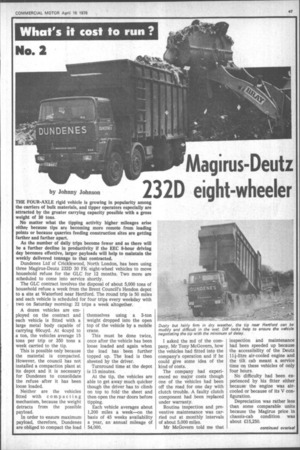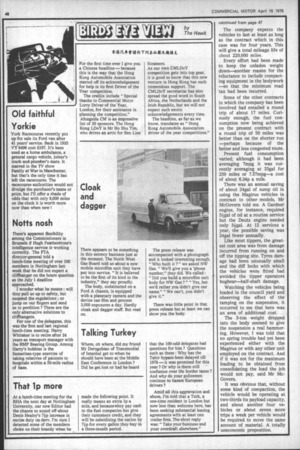Magurus-Deutz 232D eight-wheeler
Page 49

Page 50

If you've noticed an error in this article please click here to report it so we can fix it.
I asked the md of the company, Mr Tony McGovern, how the vehicles had fitted into the company's operation and if he could give some idea of the kind of costs.
The company had experienced no major costs though one of the vehicles had been off the road for one day with clutch trouble. A faulty clutch component had been replaced under warranty.
Routine inspection and preventive maintenance was carried out at monthly intervals of about 5,000 miles.
Mr McGovern told me that inspection and maintenance had been speeded up because the accessibility of the Deutz 111-litre air-cooled engine and the tilt cab meant a service time on these vehicles of only four hours.
No difficulty had been experienced by his fitter either because the engine was aircooled or because of its V configuration.
Depreciation was rather less than some comparable units because the Magirus price in chassis-cab condition was about 05,250. The company expects the vehicles to last at least as long as the contract which in this case was for four years. This will give a total mileage life of about 220,000 miles.
Every effort had been made to keep the unladen weight down—another reason for the reluctance to include compacting equipment in the bodywork —so that the minimum road tax had been incurred.
Some of the other contracts in which the company has been involved had entailed a round trip of about 17 miles. Curiously enough, the fuel consumption now being achieved on the present contract with a round trip of 50 miles was better than on the shorter run —perhaps because of the better and less congested route.
Present fuel consumption varied; although it had been averaging 7mpg it was currently averaging at 33ga1 for 250 miles or 7.57mpg—a cost of about 6.34p a mile.
There was an annual saving of about 24ga1 of sump oil in using the Magirus vehicles in contrast to othermodels, Mr McGovern told me. A Gardner engine, for instance, required 5igal of oil at a routine service but the Deutz engine needed only 3/gal. At 12 services a year, the possible saving was 24gal fewer annually.
Like most tippers, the greatest cost area was from damage incurred from running on and off the tipping site. Tyres damage had been unusually small and the duff locks with which the vehicles were fitted had avoided the tipper operators bugbear—half-shaft damage.
Watching the vehicles being loaded in the council yard and observing the effect of the tamping on the suspension, it occurred to me that here was an area of additional cost.
The 3-ton weight dropped into the body seemed to give the suspension a real hammer ing. However, I was told that no spring trouble had yet been experienced either with the Magirus or with any other unit employed on the contract. And if it was not for the maximum loading to be obtained from consolidating the load the job would not pay, said Mr McGovern.
It was obvious that, without some kind of compaction, the vehicle would be operating at two-thirds its payload capacity, and about another four ve hicles or about seven more trips a week per vehicle would be required to move the same amount of material. A totally uneconomic proposition.




























































































